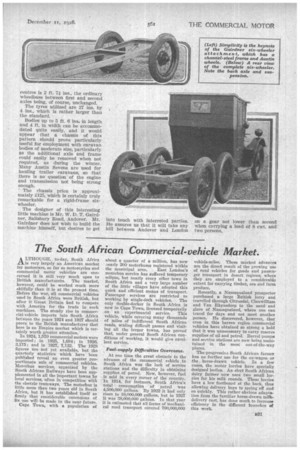The South African Commercial-vehicle Market.
Page 15

If you've noticed an error in this article please click here to report it so we can fix it.
ALTHOUGH, to-day, South Africa is very largely an American market for motorcars, so far as motorcycles and commercial motor vehiclies are concerned it is still very much open to British manufacturers. The market, however, could be worked much more skilfully than it is at the present time. Before the war, all commercial vehicles used in South Africa were British, but after it Great Britain had to compete with America for the trade in such machines. The steady rise in commercial-vehicle imports into South Africa between the years 1921 and 1927 should prove to the British manufacturer that here is an Empire market which is certainly worth greater attention.
In 1924, 1,570 commercial motors were imported ; in 1925, 1,684; in 1926, 3,175; and in 1927, 7,132. The 1928 figures are not yet available but the
quarterly statistics which have been published reveal an even greater proportionate sale of commercial vehicles. Motorbus services, organized by the South African Railways have been supplemented in all the important towns by local services, often in competition with the electric tramways. The motorbus is little more than two years old in South Africa, but it has established itself so firmly that considerable extensions of Its use will be made in the near future.
Cape Town, with a population of
about a quarter of a million, has now nearly 200 motorbuses registered within
the municipal area. East London's motorbus service has suffered temporary eclipse, but nearly every other town in South Africa and a very large number of the little villages have adopted this quick and efficient means of transport. Passenger services are restricted to
working by single-deck vehicles. The only double-decker in South Africa is now in Cape Town, licensed temporarily on an experimental service. This vehicle, while covering many thousands of miles of indifferent South African roads, scaling difficult passes and visiting all the larger towns, has proved that, under general South African conditions of working, it would give excellent service.
Fuel-supply Difficulties Overcome.
At one time the great obstacle to the advance of the commercial vehicle in South Africa was the lack of service stations and the difficulty in obtaining supplies of petrol. Now, however, fuel is sold in every corner of the country. In 1914, for instance, South Africa's total consumption of petrol was 4,500,000 gallons. By 1922 it had only risen to 10,000,000 gallons, but in 1927 it was 38,600,000 gallons. In that year it is estimated that all forms of meehanical road transport covered 700,000,000 vehicle-miles. These marked advances are the direct result of the growing use of road vehicles for goods and passenger transport in desert regions, where they are employed to a considerable extent for carrying timber, ore and farm produce.
Recently, a Namaqualand prospector purchased a large British lorry and travelled through Citrusdal, Clauwilliain and Van Rhynsdorp to the sand and glare of Namaqualand, where one can travel for days and not meet another person. He discovered, however, that even in this barren region commercial vehicles have obtained so strong a hold that it was unnecessary to carry reserve supplies of oil and petrol. Barrel pumps and service stations are now being maintained in the most out-of-the-way places.
The progressiva South African farmer has no further use for the ox-wagon or the , horse-drawn vehicle. In a few eases, the motor lorries have specially designed bodies. An alert South African dairy farther now uses two small lorries for his milk rounds. These lorries have a low footboard at the back, thus allowing delivery boys to spring off and on quickly. This rather obvious adaptation from the familiar horse-drawn milkdelivery cart, has done much to increase efficiency in the different branches of this work.






























